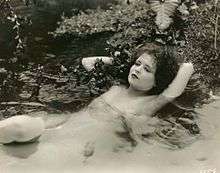Hula (film)
Hula is a 1927 American silent romantic comedy film directed by Victor Fleming, and based on the novel Hula, a Romance of Hawaii by Armine von Tempski. The film stars Clara Bow and was released by Paramount Pictures.[1]
| Hula | |
|---|---|
| Directed by | Victor Fleming |
| Produced by | Adolph Zukor Jesse L. Lasky B. P. Schulberg (associate producer) |
| Written by | Doris Anderson (adaptation) Ethel Doherty (scenario) George Marion, Jr. (titles) Frederica Sagor (uncredited) |
| Based on | Hula, a Romance of Hawaii by Armine von Tempski |
| Starring | Clara Bow Clive Brook Arlette Marchal Albert Gran |
| Cinematography | William Marshall |
| Edited by | E. Lloyd Sheldon Eda Warren |
| Distributed by | Paramount Pictures |
Release date |
|
Running time | 64 minutes |
| Country | United States |
| Language | Silent (English intertitles) |
Plot
Hula Calhoun (Clara Bow) is the daughter of a Hawaiian planter, Bill Calhoun (Albert Gran). She follows the advice of her uncle Edwin (Agostino Borgato), and follows a simple and natural life, far from social conventions of her family and is considered a "wild child" who wears pants and rides horses.[2]
Courted with adoration by Harry Dehan (Arnold Kent), Hula prefers a young British engineer, Anthony Haldane (Clive Brook), who came to the island to oversee the construction of a dam on her father's property. However, Haldane is already married. At a party, Haldane tries to keep his distance but Hula gets drunk and performs a seductive hula dance for him. She manages to provoke him so much that he promises that he will get a divorce. When his wife, Margaret (Patricia Dupont), appears, Hula makes a deal with one of the foreman to use dynamite to blow up a point on the dam. Thinking that her husband is now ruined, Mrs. Haldane agrees to the divorce, and the two lovers can finally get married.
Cast
- Clara Bow as Hula Calhoun
- Clive Brook as Anthony Haldane
- Arlette Marchal as Mrs. Bane
- Albert Gran as Bill Calhoun
- Arnold Kent as Harry Dehan
- Patricia Dupont as Margaret Haldane
- Agostino Borgato as Uncle Edwin
- Duke Kahanamoku as Hawaiian boy
Production

In the opening scene of the film Hula is shown swimming nude in a stream, and later is wearing pants and articulates her sexual desires.[2] Similar to Sadie Thompson (1928), the film depicts a modern woman who is located outside the bounds of American civilization and thus able to act in an "uncivilized" manner like natives who live on the islands.[3][4]
See also
- Nudity in film
- The White Flower (1923)
References
- Progressive Silent Film List: Hula at silentera.com
- Fischer, Lucy (2003). Designing Women: Cinema, Art Deco, and the Female Form. Columbia University Press. pp. 174–76. ISBN 0-231-12501-1.
- Schlater, Angela (December 2008). Flaming Youth: Gender in 1920s Hollywood. Ann Arbor, Michigan: ProQuest. pp. 91–93. ISBN 0-549-94439-7.
- Wood, Houston (1999). Displacing Natives: The Rhetorical Production of Hawaiʻi. Lanham, Maryland: Rowman & Littlefield. pp. 104–05. ISBN 0-8476-9141-1.
External links
| Wikimedia Commons has media related to Hula (film). |